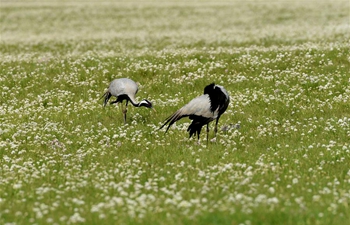by Carina Lopez
MEXICO CITY, Aug. 18 (Xinhua) -- Massive quantities of Sargassum seaweed are invading Caribbean beaches mostly thanks to global warming and countries should work closely with scientists for a sustainable solution, said a researcher at a leading Mexican university on Saturday.
Brigitta Ine Van Tussenbroek, an expert on tropical marine vegetation, is from the Netherlands and is now working as a senior researcher at the Institute of Ocean Sciences and Limnology in the National Autonomous University of Mexico (UNAM).
"The original Sargasso Sea was located close to the Bermuda Islands, and the rising sea temperature in the last decade has allowed the seaweed to grow enormous amounts in northern Ecuador," she told Xinhua.
According to the Dutch expert, the presence of Sargassum could alter the local ecosystem.
"If this crisis continues and is not managed properly, it will permanently change the ecosystem; this is a very serious problem," she said.
Sargassum has already become a nuisance on beaches in the southeast Mexican state of Quintana Roo, where major holiday resort Cancun is located.
The seaweed's brown color and unpleasant smell is a negative factor for tourism, which according to government data accounts for 8.5 percent of the Mexican economy.
"This crisis is an indicator of growing contamination and the damage caused directly by human activities, 100 times worse than before, in the seas and coasts of the Caribbean," Ine Van Tussenbroek said.
To counter this threat, the head of the Seagrass Laboratory of the UNAM wants to create a comprehensive management plan that combines science, legislation, economic investment and the participation of local people.
The UNAM and the Mexican government have also formed a scientific committee to provide solutions.
Following advice from the university, the initial step will be to improve seaweed collection systems.
The effectiveness of the three-mile (about 4.8 km) ocean barrier already installed around beaches in Quintana Roo will be evaluated, and plans for a sustainable removal of the seaweed will be moved forward.
Seaweed arrival warning systems will be tested, to be supported by satellite technology from UNAM's Geography Institute.
Lastly, a feasibility study is underway on the industrial-scale use of seaweed so that an economic value can be extracted from the organic waste.
Experts are already considering the use of the Sargassum in food, pharmaceuticals and cosmetics, or as a biofuel.
"Extensive studies are needed to stop the Sargassum crisis in Mexico," said Ine Van Tussenbroek, "but the international scientific community has been consulted and we have already had a very important exchange of information."

















